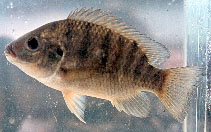| Family: |
Cichlidae (Cichlids), subfamily: Pseudocrenilabrinae |
| Max. size: |
30 cm SL (male/unsexed) |
| Environment: |
benthopelagic; freshwater |
| Distribution: |
Africa: present in the basins of the Ogooué, Nyanga, Kouilou-Niari and Chiloango, Gabon to Democratic Republic of the Congo (Ref. 2, 81260). Reports from Gambia and Senegal (Ref. 3538) and Guinea (4517) are doubtful and need confirmation (see Ref. 2, 81260). Also reported from the Cuanza (Angolan coastal) and the southern Congo River basin in Angola (Ref. 120641) but considered a Lower Guinea endemic in Ref. 81260; needs confirmation. |
| Diagnosis: |
Dorsal spines (total): 14-16; Dorsal soft rays (total): 12-13; Anal spines: 3-3; Anal soft rays: 9-11; Vertebrae: 27-29. Diagnosis: scales of cheek in 2 or usually 3 horizontal rows; in mature males preorbital bone and jaws enlarged; upper profile of head often concave; outermost teeth bicuspid, and inner tricuspid in immature fishes and females, all becoming unicuspids in males; male genital papilla spade-shaped; margins of dorsal and caudal fins red in mature males (Ref. 2).
Description: very deep-bodied when adult; mouth relatively small in juveniles, but larger in adults; snout large and possesses a duckbill-like shape, especially in old males (Ref. 52307). Head length 34.0-38.0% SL; lower pharyngeal jaw with unicuspid anterior teeth and straight posterior teeth; ventral keel elongated, as long, or longer, than dentigerous plate; 4-6 rows of teeth in oral jaws, outer row teeth bicuspid (Ref. 81260).
Coloration: base body color pale or whitish, light grey dorsally, preorbital olive-green; lips paler than snout; flank scales with central blue-red spot (Ref. 81260). Numerous, irregularly arranged black spots on cheeks (Ref. 52307), opercle (Ref. 52307, 81260) and occiput, concentrated around sensory canal pores (Ref. 81260). Dorsal fin greyish with a large yellowish white distal submargin becoming red marginally; spinous dorsal with some oblique clear lines, very thin between spines, soft dorsal with many clear maculae (Ref. 81260). Caudal fin greyish with many clear maculae, sometimes aligned between rays (Ref. 81260), distal margin red (Ref. 52307, 81260). Anal fin greyish (Ref. 52307, 81260) with some clear maculae between soft rays, proximally tinted red (Ref. 81260). Pelvics whitish to transparent (Ref. 81260). Juveniles: tinted with green, with 6-8 darker vertical bars on the flanks; dorsal, caudal and anal fins greenish grey, with some clear maculae between soft rays; pelvics and pectoral fins transparent (Ref. 81260). Males usually exhibit a red dot at the center of each body scale (Ref. 52307). |
| Biology: |
Occasionally territorial; stomachs contained algae, mainly unicellular or in short filaments (Ref. 2). Arena-spawning, exclusively maternal mouthbrooder with marked sexual dichromatism when sexually active (Ref. 81260). |
| IUCN Red List Status: |
Least Concern (LC); Date assessed: 01 May 2009 Ref. (130435)
|
| Threat to humans: |
harmless |
Source and more info: www.fishbase.org. For personal, classroom, and other internal use only. Not for publication.

